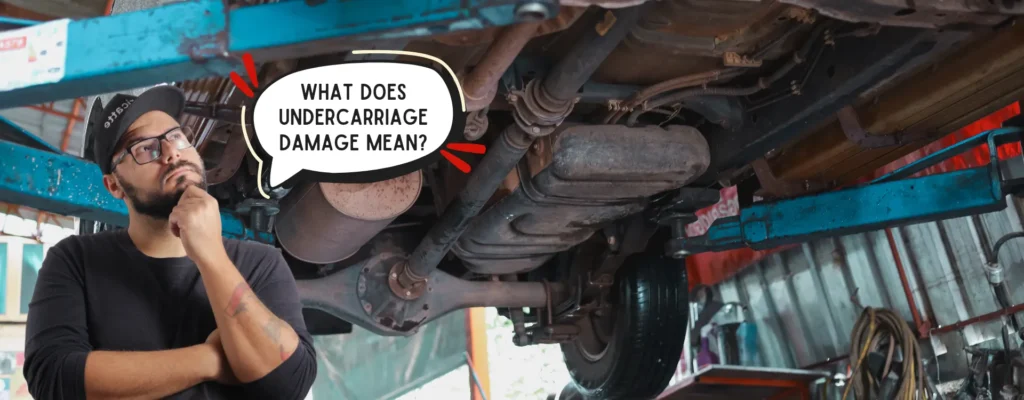- Understanding Damage on the Undercarriage
- Causes of Undercarriage Damage
- What Does Undercarriage Damage Mean? Identifying Signs of Under Car Damage
- Consequences of Ignoring Under Car Damage
- How to Prevent Different Types of Undercarriage Damage
- Finding a Reliable Body Shop: Benefits of Professional Repair

When it comes to car maintenance and repair, understanding the different types of damage that can affect your vehicle is important. One often overlooked but critical area is the undercarriage, particularly after a car accident.
This blog will answer “what does under car damage mean” and explore its causes, the signs to watch out for, and why it’s necessary to address the issue immediately.
IN NEED OF A POST- ACCIDENT CAR REPAIR?
Understanding Damage on the Undercarriage
The undercarriage of a vehicle refers to the components located on the underside of the car. This covers the frame, exhaust system, suspension, and other essential parts that support the vehicle’s structure and functionality. It includes any damage that affects these parts.
Causes of Undercarriage Damage
Damage to the undercarriage can result from various factors, including:
- Road Conditions: Driving on uneven, rocky, or unpaved roads can cause under car damage. Potholes, speed bumps, and debris can also contribute to wear and tear.
- Weather: In California, while we don’t deal with much snow, rain can lead to water pooling on roads. Driving through these pools can cause rust and corrosion on the undercarriage.
- Accidents: Collisions or hitting objects on the road can lead to significant undercarriage damage. Even minor impacts can harm vital components.
- Wear and Tear: Over time, regular driving can cause natural wear and tear on the undercarriage, leading to potential issues.
What Does Undercarriage Damage Mean? Identifying Signs of Under Car Damage
Visual Inspection
Regularly checking your vehicle’s underside can help identify damage early. Look for signs such as:
- Scratches and Dents: Visible scrapes and dents can indicate impact damage.
- Rust: Rust spots or patches on metal parts can suggest exposure to water and poor maintenance.
- Loose Parts: Any hanging or loose components should be a red flag.
Unusual Sounds
Strange noises can also signal undercarriage issues and affect a vehicle’s performance. Pay attention to:
- Clunking or Rattling: This could indicate loose parts or damage to the suspension system.
- Squeaking: Often a sign of worn-out components or rust.
Handling Issues
If your car handles differently, the extent of damage might be huge. Watch for:
- Pulling to One Side: This can suggest alignment issues often caused by suspension or frame problems.
- Vibrations: Feeling unusual vibrations, especially when driving over smooth surfaces, could indicate problems with the tires and axles.
Consequences of Ignoring Under Car Damage
Ignoring under car damage can lead to severe consequences, including:
Safety Risks
Damaged undercarriage components can compromise your vehicle’s safety. For example, a weakened frame or damaged suspension can lead to poor handling and increased accident risk.
Increased Repair Costs
Minor issues can escalate into major problems if left unaddressed. Fixing severe under car damage is typically more expensive than addressing minor issues early on.
Reduced Vehicle Lifespan
Continuous neglect of undercarriage problems can reduce your vehicle’s overall lifespan. Maintaining your undercarriage ensures your car remains reliable and functional for years.
How to Prevent Different Types of Undercarriage Damage
Preventive measures can help protect your vehicle from underside and frame damage:
Drive Carefully
Avoid driving on rough, uneven terrain whenever possible. Slow down when approaching speed bumps and potholes to minimize impact.
Regular Maintenance
Routine maintenance, including regular inspections and cleaning, can prevent rust and catch potential issues early. Ensure your vehicle’s undercarriage is part of your regular maintenance checklist.
Use Protective Coatings
This can help prevent rust and corrosion and is especially useful in areas with high humidity or frequent rain.
Finding a Reliable Body Shop: Benefits of Professional Repair
Addressing undercarriage problems promptly is essential to maintaining your vehicle’s safety and performance. When you need professional help, finding a reliable body shop is crucial.
Professional body shops have the expertise and equipment to accurately diagnose and repair the problem. They can thoroughly inspect, provide quality repairs, and even offer a warranty on service — giving you peace of mind.
Undercarriage damage is a serious issue that can affect your vehicle’s safety and longevity. To ensure your vehicle gets the best care, consider finding a reliable body shop through the Collision Connect network. We carefully vet our partners to ensure that you work with only the best in your area.
Find an Auto Body Shop near you today.
IN NEED OF A POST- ACCIDENT CAR REPAIR?